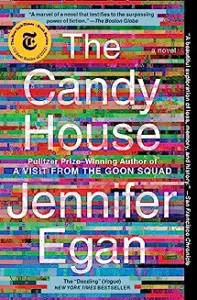The Candy House by Jennifer Egan 2022
Egan is among our most ‘prized’ contemporary novelists having won the Pulitzer, the National Book Critics Circle, the Andrew Carnegie Medal for Excellence in Fiction, garnering a National Book Award nomination, and ‘The Candy House’ was named one of the New York Times’ Ten Best in 2022. So it was with great anticipation that I began this book. Sadly, I ended up disappointed.
It’s her usual fine plotting with many (way too many, in my opinion) finely drawn characters and a complex, interwoven plot, but as too many novels these days, it is a tad too dystopian for me. Taking place in an undefined future (the only clue we have to the actual time is a reference to one character’s death in 2034), we find ourself in a world where the internet has evolved from a system that can provide information about anything, anytime, anywhere to one which provides the means to store your entire history of memories and consciousness. In addition, you can ‘load’ your memories into the collective consciousness, a ‘memorevolution’.
The development of this universal consciousness was the work of a man named Bix Bouton whose company Mandela was built upon the work of a social scientist named Miranda. Her seminal book on inherent social affinities found in a remote Brazilian tribe were converted by Bouton into the basis for social media’s predictions of behavior. Bix, famous and rich in his 30’s, is searching for that ‘next big thing’ when he goes incognito to a discussion group that follows a lecture by Miranda, and has another epiphany for the future. It is the members of that discussion group who are the primary characters in the novel with Bix not appearing again after the first chapter until the final chapter as he is dying. Instead, we learn about the parents, grandparents, partners, etc of the discussion group members, and I had a difficult time keeping track of everyone as the characters and side stories piled up.
The sections of the book are labelled Build, Break, Drop and Build as this next generation of social media begins to control the world. There are the usual ‘rebels’, the eluders who refuse to participate in big data analyzed by the ‘counters’ as it increasingly appears that free will is a myth. The title, ‘Candy House’ is mentioned twice. The first time it’s in reference to Hansel and Gretel’s plight—‘Nothing is free….Never trust a candy house.’—as Miranda’s daughters struggle with the demise of their father’s music industry business, destroyed by the free sharing of streaming. The second time, the old music gang has gathered again to issue a new recording by the Conduits, produced by one of the members of the Flaming Dildos, Bennie Salazar who says “The only route to relevance at our age is through tongue-in-cheek nostalgia, but that is not our ultimate ambition. Tongue in cheek nostalgia is merely the portal, the candy house, if you will, through which we hope to lure in a new generation and bewitch them.” Again, the Hansel and Gretel motif.
Though not entirely sure (speaking of a new generation!!!!), I think Egan is warning us that social media, the internet, the collective big data approach to marketing almost everything these days, is risky. a candy house which promises a bright future for all at no cost but which is ultimately a trap, a limitation of our free will and choices. There’s enough trouble in today’s real world that I generally stay away from dystopian fiction. Egan writes masterfully, but the message and the mode in which it was sent was not one I was looking for. On the other hand, if you love good writing, you might give this brilliantly constructed novel a try. I believe that would be the suggestion of Dwight Gardner who wrote a very positive review in the New York Times and described the novel in this way: “The Candy House” is a trim 334 pages, but it has a dwarf-star density. Inside, 15 or 20 other novels are trying to climb out. The chapters are short; the tone is aphoristic; the eye for cultural and social detail is Tom Wolfe-like”.



